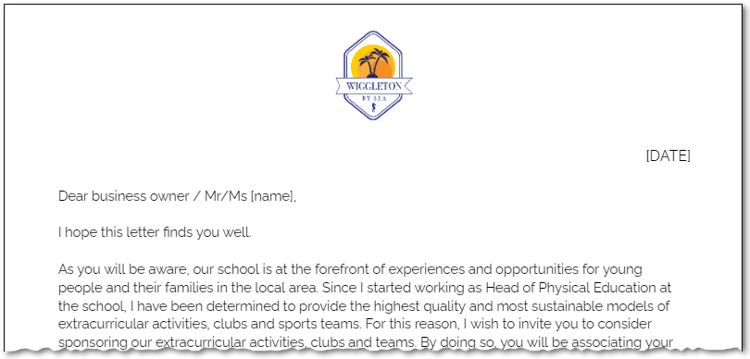Local Sponsorship for your School Teams and Extra-curricular - A sustainable model for now and the future?
It is a real sinking feeling when a PE teacher attends a fixture and their squad is perceived as scruffy or ill-matching in terms of their kit. Having worked in six different state schools and colleges in the UK, I have experienced this many times.
Heads of PE face many, many pressures on their annual budgets. Physical education budget management can often feel like trying to stem a flood. Every time you think you have the budget under control, there is another demand on that money. In the end, something has to give and a purchase has to be delayed. Meanwhile, PE teachers want to give their students the best experience during extracurricular provision. Sporting fixtures need to be resourced and this resourcing costs money! Sporting kits are expensive and it is very easy to delay purchase of netball or football kits, say, as described above. In this context, many heads of PE turn to the possibility of external sponsorship and this blog post is aimed to support any teacher considering this move. Please, read through the entire post and consider using my letter templates to communicate with your community.
This post will be separated into five sections, all of them integrated and all of them crucial. I will write from all perspectives on this topic in an attempt to help you consider all stakeholders. This is what you can expect:
- The ethical reasons to consider external sponsorship of sports kit ➚
- The reasons why a business will sponsor and how to use these reasons to your advantage ➚
- How to achieve support for your project ➚
- How to communicate with stakeholders ➚
- How to cause a business to renew their sponsorship in the future ➚
You may well feel squeamish about sourcing external funding for your kit and displaying logos on your students as they play and compete. Assuming that you have communicated effectively with all stakeholders, you shouldn’t. Sports sponsorship, done properly, can be a very positive move for all stakeholders.
If we break sponsorship down, it is the payment of money by a business for the exposure of that business to a community. That is it. Businesses advertise all the time. For example, every time you, your students or the parents/guardians of your students enter a Google search, they are being advertised to. Every time you all switch on a sporting TV programme, the same. Our world - to almost quote Madonna - is a commercial one. There is nothing intrinsically wrong with a PE department benefitting from the availability of this model.
Furthermore, you are providing a wonderful life experience to the young people that participate in your sports teams, clubs and fixtures. In other words, your product is “good”... it is “wholesome”... and it is reasonable to provide the best experience possible to those young people. If you are able to source responsible, reputable businesses to support your provision over time, this is an ethical approach to provision.
With these main points in mind, I want to stress the ethical basis for acquiring sponsorship:
- Sponsorship can be the basis of a sustainable model of financing for your sports teams allowing you to plan long term and deliver better experiences.
- Businesses benefit from sponsorship if it is well structured and supported. Providing clarity to the business in your initial communications will provide them with confidence.
- Your school/college is a commercial organisation with a history of making expenditure and income decisions, probably over many, many years. This may well include previous sponsorship deals with local businesses.
- Your school/college is a hub for the local community and provides an essential service to the families of local people but, crucially, also their businesses. Therefore, local businesses are incentivised to support your work.
- Appropriate sponsorship is a positive step for all stakeholders. If you acquire a good relationship with a good local business, you are supporting that business to be more visible to your local community and, in turn, provide good services to local people.
Before considering who to approach and how to do so, it is worth considering the reasons why a business would choose to sponsor your provision. To some degree, these reasons are ranked and I encourage you to consider the ones at the top as the most significant ones. Please, also note that I am writing these points from the perspective of being a business owner who has and does sponsor school provision and events.
- Businesses expect to be asked first to sponsor your provision if they have an existing relationship with you or with the school. Therefore, it is essential that you approach businesses who have previously supported the school first. If you do not, these businesses could feel snubbed.
- Businesses may have a vested personal interest in you providing high-quality experiences to your students. Parents are obvious examples of this but other business owners or managers may well have links to your school/college as ex-pupils or equivalent. In other words, businesses will appreciate your approach and will like what you are asking.
- Well-structured sponsorship can give local businesses excellent exposure in the local market. Let’s use the example of an independent estate agent in your town. An estate agent wants to become the most visible provider in the area. They will use “For sale” and “Sold” boards, social media as well as advertising to achieve this but a wonderful step is to be associated with other, positive local provision. Your sports teams and clubs are exactly that!
- Businesses receive tax relief on sponsorship payments. In other words, the £500 per year they give you, say, is tax deductible and, therefore, does not cost the business £500 in real terms. The business needs to be confident that:
● The sponsorship promotes the business?
● The purpose of the sponsorship is ‘wholly and exclusively’ business related
● The benefit of the sponsorship is ‘wholly and exclusively’ business related
(Information taken from the gov.uk website)
So, if the deal you strike satisfies these requirements, sponsorship payment is cheap for the business. - Modern sponsorship is significantly more than a logo on a football shirt. Take my example of the local estate agent. Whilst this agent may well retain a physical, high-street store, the vast majority of their business will be done online. Therefore, their “shopwindow” is mostly a virtual one. For this reason, businesses will value sponsorship which has an online footprint and that can encourage local people to their sales pages. Therefore, your social media is a brilliant way to increase the value of the sponsorship deal.
3. How to achieve support for your project
It is essential that your project is supported by your senior leadership team. You absolutely must not pursue sponsorship without the advanced permission of your headteacher. Arrange a meeting with the relevant person or team (typically the headteacher and/or the business manager) and use the following points to support your decision:
- External sponsorship is a sustainable funding model and the systems you implement will be utilisable long term.
- With the incredible diversity that you offer in PE, external sponsorship is an excellent way to ensure that all elements of the PE department’s provision are high quality.
- Sports teams and fixtures provide a window for the local community into the workings of the school. If the team, say, looks smart and well presented, this makes an excellent impression on the local community.
- Building associations with positive and appropriate local businesses is a clear example of community engagement and affiliation and will increase the value that the community has in your PE and sport provision.
- Longer term, sports captains and senior students will become involved in the process of acquiring sponsorship and this will develop excellent skills and experiences for these individuals at the right time.
Now, your headteacher/business manager may well have reservations. I have included some examples below with possible refutations:
With these responses prepared in advance, it is exceptionally likely that your senior colleagues will support you. I would like to add that this is an excellent way to approach any meeting with senior colleagues and the mentality we need to have is that of the middle leader who is excellent at “managing up” as well as down.
4. How to communicate with stakeholders
I encourage you to write to two main stakeholders:
- Parents and families of current and ex-students
- Local, reputable businesses
For this reason, I have written two letters which you can download and use for these purposes. Please, note that the letters are entirely editable and you are encouraged to personalise them to your own context.
Letter 1: Parental letter
Objective/Call to action: To acquire the name and email address of local business owners who can be approached with Letter 2.You can find an editable copy of this letter here.
Letter 2: Business contact letter
Objective/Call to action: To cause the recipient to respond to your communication via email. It is unlikely that you will acquire a sponsorship commitment in one communication, so your aim is to get the business to engage. Once the recipient responds, you have an excellent opportunity to “convert” them to a sponsorship deal.
You can find an editable copy of this letter here.
*Predicted ratios: (*Assuming you only send your letter once.)
| Open rate | 35% |
| Response rate | 5% |
| Confirmation rate | 2% |
Therefore, in order to achieve four confirmed sponsors, the following numbers would apply:
| Number of letters sent | 200 |
| Number of letters opened | 70 |
| Number of responses | 10 |
| Confirmed sponsorship arrangements | 4 |
I've created a sample spreadsheet that you can use to track progress with your potential sponsors.
5. How to cause a business to renew their sponsorship in the future
It is important to remember that your aim is not simply to acquire sponsorship once. Rather, you should consider that each business that responds to you is, at the very least, capable of two sponsorship deals: one in the immediate term and a further one at a point of renewal.
For this reason, you should plan your conversations with businesses with this in mind and you should guarantee them the following:
- Committing to sponsorship now provides them the guarantee of first refusal in the future.
This will help to sow the seed that the business is engaging with you long term.
Beyond this, you should do your utmost to communicate with the business over the cycle of the deal. For example, ensure that you:
- post positive social media images with the business name and logo clearly visible;
- tag the business on social when you post about that team/club/activity; and
- thank the business on social when you make the posts mentioned above.
By doing this, you not only maintain communication with the business, but you help to solve a pain point for the business, which is what to post about on social media. This is a headache for many businesses and you will be popular by providing them with material.
So, there you have it. This is an introduction and some useful materials to get started in your sponsorship journey. If you require further guidance or there are other materials that would benefit you, please do mention this in a comment below. I am happy to receive these requests and I will do my best to resource you in future posts.
Have a wonderful day.
%20Text%20(Violet).png)




